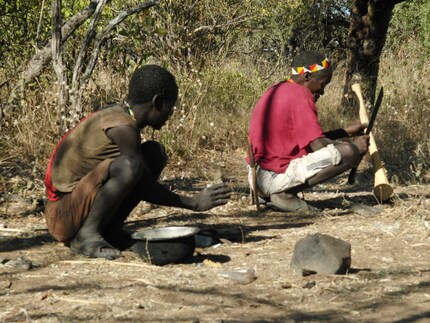
Guide
Weight loss: can ketones really turbocharge your metabolism?
by Anna Sandner

People from a hunter-gatherer culture rest for around the same amount of time per day as we do. However, they do not sit on a chair, but squat or kneel. This makes a big difference, say researchers.
In evolutionary terms, it can be beneficial to move less. If you save energy, you have more resources available for reproduction and other important tasks - or can survive for years without food. While the great apes, which are closely related to us, are less physically active and yet healthy and slim, our bodies have adapted over the course of evolution to the strenuous life as hunter-gatherers. To stay healthy, we therefore need to move a lot.
The fact that indigenous ethnic groups such as the Hadza, who live as a hunter-gatherer community in northern Tanzania, are largely free from cardiovascular and other diseases of civilisation also speaks in favour of this. This makes them popular test groups: For many years, research teams led by anthropologist Herman Pontzer from Duke University in North Carolina have been studying the relationship between diet, exercise and metabolic activity.
We are partners of Spektrum der Wissenschaft and want to make well-founded information more accessible to you. Follow Spektrum der Wissenschaft if you like the articles.
[[small:]]
Experts from science and research report on the latest findings in their fields – competent, authentic and comprehensible.
Practical solutions for everyday problems with technology, household hacks and much more.
Show allSitting is often said to be the new smoking. Numerous studies have shown that sitting for hours on end increases our risk of diabetes and cardiovascular disease. These are the number one cause of death in this country. According to the German Health Report Diabetes 2020, our western working and living environment has turned us into a nation of "sitters" and "stayers". According to the report, we sit for around 7.5 hours a day and only take around 5,000 steps instead of the 10,000 recommended by the World Health Organisation (WHO). This figure is likely to be even lower for office workers.
Apparently, the key to health lies not only in exercise, but also in the way we rest. According to a new study, which a team led by evolutionary biologist David Raichlen from the University of Southern California, of which Pontzer was also a member, has now published in the scientific journal "PNAS", the Hadza spend around the same amount of time per day in resting positions as people from industrialised countries. That sounds surprising at first. Are the Hadza also sedentary people? No, says Raichlen's team. This is because the Hadza's resting positions require considerably more energy than sitting on an office chair, for example.

For eight days, the researchers tracked every step and movement of 28 members of the hunter-gatherer culture. To do this, they attached a motion sensor to the thighs of 16 Hadza men and 12 Hadza women aged between 18 and 61. Using software, the scientists determined that the test subjects exercised very intensively for one to two hours a day. This puts them well above the WHO's recommendation of 150 minutes of physical activity per week for adults. The Hadza rested for more than nine hours of the time they were awake, i.e. they did not stand or walk. According to the researchers, people from the USA, the Netherlands and Australia spend about the same amount of time sitting down every day.
However, the blood lipid, blood sugar and cholesterol levels of the test subjects did not indicate cardiovascular disease. From this, the researchers concluded that the type of rest must be less important than the duration. Instead of sitting on a chair with their legs bent, the Hadza often sit cross-legged on the floor, kneel or crouch on a stone. By attaching special measuring electrodes to the muscle groups involved, the researchers found that these positions put more strain on the lower limbs than sitting in a Western chair. In the squatting position, in which the test subjects spent around two hours a day, their muscles used 20 to 40 per cent of the energy they need to walk, for example.
When we sit, our muscles run on the back burner. Our fat and sugar metabolism slows down, as does our blood flow. According to the researchers, adopting a more active sitting posture and thus generating more muscle activity could help us to reduce our risk of cardiovascular disease. So away with the office chair and onto the floor? That would make working at the computer considerably more difficult. Would you rather sit on an exercise ball? That would certainly not be a bad idea, as the body has to constantly compensate for the slight movements of the ball. However, sports scientists recommend not sitting on it for more than 30 minutes at a time to prevent overloading the small muscles in the spine. It is also controversial whether such balls actually increase the activity of the back and core muscles. Raichlen and his team also want to investigate this aspect of Hadza resting positions in the future. So far, they have focussed solely on the leg muscles.
Numerous studies have shown that it is better to stand or walk from time to time than to sit motionless for long periods of time. In terms of cardiovascular disease, this is even more effective in the long term than interspersing short periods of intensive exercise - i.e. sport, the researchers write. In future studies, they now want to investigate how a more active sitting position, which is maintained over a longer period of time, affects the blood values of test subjects.
However, it should not be forgotten that diet also plays an important role. While indigenous peoples such as the Hadza only eat what nature has to offer, people in industrialised countries generally have access to highly processed and high-calorie foods. Being overweight and obese is also known to increase the risk of diabetes and cardiovascular disease. Nutrition researchers now know that physical activity has much less of an effect on body weight than assumed. Pontzer's team has also repeatedly found that people from hunter-gatherer cultures, who are much more active than we are, do not have significantly higher energy requirements. This means that if we want to lose weight, it is not enough to move more or sit differently. To find out whether the resting position actually has an effect on cardiovascular health, we would therefore also have to take into account the nutritional status of the test subjects and examine people from different cultures.

Siemens EQ700 integral TQ717D03